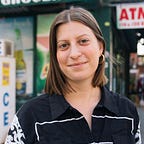Before engaging a community, journalists should hit the books.
Re-examing the theories and methods behind our work can help journalists make knowledge production more collaborative, communal and representative of different people’s realities.
I often find myself reflecting on what we really mean when we as journalists say we want our work to be a public service.
What would it look like for journalism to truly serve the public?
This week, Dr. Lisbeth Berbary, an expert in qualitative research methods and associate professor at the University of Waterloo, challenged me to take that line of thinking one step further when she asked, “Who is the public, anyway?”
Her point was that thinking critically about what the public means, who the public is and how our work should engage the public forces us to as different questions, and to yield different outputs.
And that thinking about those kinds of questions in that way is actually super similar to the work that she does as a qualitative researcher.
She said that researchers in her field have been asking similar kinds of questions and have come up with processes for exploring them and creating knowledge in light of these complicated questions.
Tools used in the qualitative research design process, such as epistemologies, theories, methodologies and forms of analysis, could prove quite useful for examining our role as journalists and the way that we are gathering and sharing information in communities.
Berbary suggested that borrowing a few pages from social scientists’ notebooks and using some of the structures of social theories and research methods could help journalists do our jobs better.
“Journalism and social sciences currently have a lot more to dialogue about than ever before,” Berbary said, noting that we are in an age when the notion of “truth” often comes into question.
She noted that whether we name it or not, any kind of inquiry, including the kind of information gathering, investigating and interviewing that journalists do every day as part of our practice, is driven by theory and methods. In other words, there are guiding principles behind our journalism work whether we choose to identify them or not.
When we ignore that, we risk operating more blindly from a place of assumptions, personal biases and existing oppressive historical power structures, according to Berbary.
A theoretical framework can provide a plan and a way for journalists to more authentically and productively engage community members in the process of what she called “knowledge production.” (Side note: I think the concept of knowledge production is such a cool and aspirational way to think about journalism!!)
Berbary said that theories and methods can make knowledge production more meaningful and accessible and can help further the goal, “to produce knowledge with others instead of about or for others,” because a lot of the ways of gathering knowledge call into question whose voices are valuable, and how those voices are being filtered through other people, like a researcher or a journalist.
Berbary said that by using theory, it helps open up the possibilities of journalists exploring and sharing information about a reality that consists of “multiple truths” instead of one “capital T truth,” and it encourages reporters to use more precise terms for what it is that we are doing, such as understanding, critiquing or deconstructing.
Several tools from Berbary’s apparatus made me especially curious about the overlap between qualitative research and journalism, especially the methods of participatory action research, narrative inquiry, re-storying and ethnography.
And on a more basic level, I am curious about the ways that journalism could benefit from making a more academic “purpose statement” before embarking on any ambitious projects.
I think this simple practice could be transformational in how we as journalists engage our audiences, as it would force us to root the way we do things back to an identified goal for what we hope to learn, how we choose to include community members in that learning process and how we hope to represent and distribute what we learned.
From past academic and life experiences, I am loosely familiar with a lot of these theories of social thought, but I am really excited to try to challenge myself to think more critically and apply these lenses more explicitly to my journalism work.
I’m hopeful to see how such frameworks can inform projects like the Open Newsroom to come up with new, creative ways to collaborate with community members in learning, gathering and sharing information in neighborhoods.
Source:
2014, Berbary, Lisbeth, A Very Basic Review Packet for Humanist Qualitative Research, University of Waterloo
